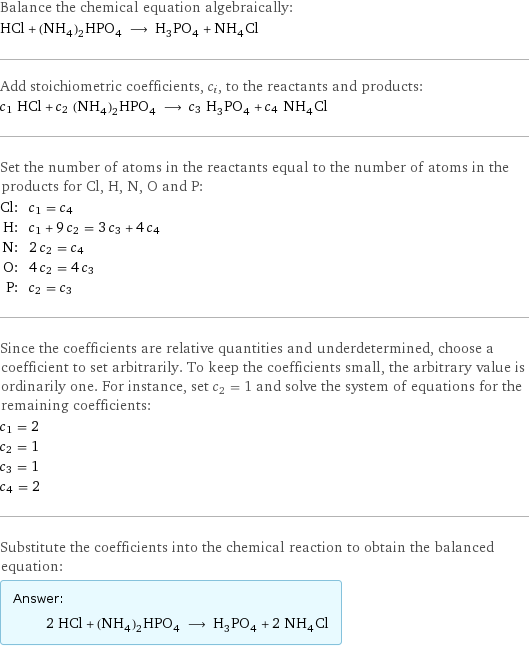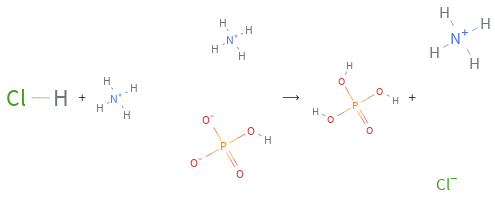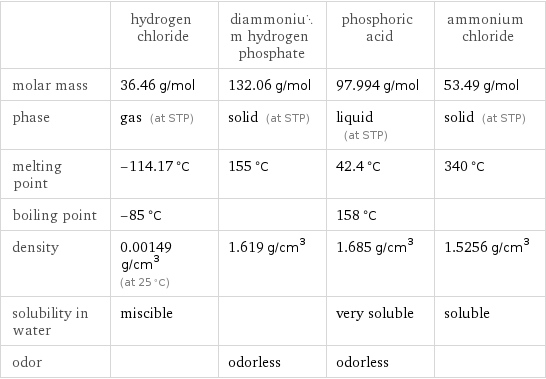Input interpretation

HCl hydrogen chloride + (NH_4)_2HPO_4 diammonium hydrogen phosphate ⟶ H_3PO_4 phosphoric acid + NH_4Cl ammonium chloride
Balanced equation

Balance the chemical equation algebraically: HCl + (NH_4)_2HPO_4 ⟶ H_3PO_4 + NH_4Cl Add stoichiometric coefficients, c_i, to the reactants and products: c_1 HCl + c_2 (NH_4)_2HPO_4 ⟶ c_3 H_3PO_4 + c_4 NH_4Cl Set the number of atoms in the reactants equal to the number of atoms in the products for Cl, H, N, O and P: Cl: | c_1 = c_4 H: | c_1 + 9 c_2 = 3 c_3 + 4 c_4 N: | 2 c_2 = c_4 O: | 4 c_2 = 4 c_3 P: | c_2 = c_3 Since the coefficients are relative quantities and underdetermined, choose a coefficient to set arbitrarily. To keep the coefficients small, the arbitrary value is ordinarily one. For instance, set c_2 = 1 and solve the system of equations for the remaining coefficients: c_1 = 2 c_2 = 1 c_3 = 1 c_4 = 2 Substitute the coefficients into the chemical reaction to obtain the balanced equation: Answer: | | 2 HCl + (NH_4)_2HPO_4 ⟶ H_3PO_4 + 2 NH_4Cl
Structures

+ ⟶ +
Names

hydrogen chloride + diammonium hydrogen phosphate ⟶ phosphoric acid + ammonium chloride
Equilibrium constant
![Construct the equilibrium constant, K, expression for: HCl + (NH_4)_2HPO_4 ⟶ H_3PO_4 + NH_4Cl Plan: • Balance the chemical equation. • Determine the stoichiometric numbers. • Assemble the activity expression for each chemical species. • Use the activity expressions to build the equilibrium constant expression. Write the balanced chemical equation: 2 HCl + (NH_4)_2HPO_4 ⟶ H_3PO_4 + 2 NH_4Cl Assign stoichiometric numbers, ν_i, using the stoichiometric coefficients, c_i, from the balanced chemical equation in the following manner: ν_i = -c_i for reactants and ν_i = c_i for products: chemical species | c_i | ν_i HCl | 2 | -2 (NH_4)_2HPO_4 | 1 | -1 H_3PO_4 | 1 | 1 NH_4Cl | 2 | 2 Assemble the activity expressions accounting for the state of matter and ν_i: chemical species | c_i | ν_i | activity expression HCl | 2 | -2 | ([HCl])^(-2) (NH_4)_2HPO_4 | 1 | -1 | ([(NH4)2HPO4])^(-1) H_3PO_4 | 1 | 1 | [H3PO4] NH_4Cl | 2 | 2 | ([NH4Cl])^2 The equilibrium constant symbol in the concentration basis is: K_c Mulitply the activity expressions to arrive at the K_c expression: Answer: | | K_c = ([HCl])^(-2) ([(NH4)2HPO4])^(-1) [H3PO4] ([NH4Cl])^2 = ([H3PO4] ([NH4Cl])^2)/(([HCl])^2 [(NH4)2HPO4])](../image_source/e53af0562c9160c3498f47a084d62f27.png)
Construct the equilibrium constant, K, expression for: HCl + (NH_4)_2HPO_4 ⟶ H_3PO_4 + NH_4Cl Plan: • Balance the chemical equation. • Determine the stoichiometric numbers. • Assemble the activity expression for each chemical species. • Use the activity expressions to build the equilibrium constant expression. Write the balanced chemical equation: 2 HCl + (NH_4)_2HPO_4 ⟶ H_3PO_4 + 2 NH_4Cl Assign stoichiometric numbers, ν_i, using the stoichiometric coefficients, c_i, from the balanced chemical equation in the following manner: ν_i = -c_i for reactants and ν_i = c_i for products: chemical species | c_i | ν_i HCl | 2 | -2 (NH_4)_2HPO_4 | 1 | -1 H_3PO_4 | 1 | 1 NH_4Cl | 2 | 2 Assemble the activity expressions accounting for the state of matter and ν_i: chemical species | c_i | ν_i | activity expression HCl | 2 | -2 | ([HCl])^(-2) (NH_4)_2HPO_4 | 1 | -1 | ([(NH4)2HPO4])^(-1) H_3PO_4 | 1 | 1 | [H3PO4] NH_4Cl | 2 | 2 | ([NH4Cl])^2 The equilibrium constant symbol in the concentration basis is: K_c Mulitply the activity expressions to arrive at the K_c expression: Answer: | | K_c = ([HCl])^(-2) ([(NH4)2HPO4])^(-1) [H3PO4] ([NH4Cl])^2 = ([H3PO4] ([NH4Cl])^2)/(([HCl])^2 [(NH4)2HPO4])
Rate of reaction
![Construct the rate of reaction expression for: HCl + (NH_4)_2HPO_4 ⟶ H_3PO_4 + NH_4Cl Plan: • Balance the chemical equation. • Determine the stoichiometric numbers. • Assemble the rate term for each chemical species. • Write the rate of reaction expression. Write the balanced chemical equation: 2 HCl + (NH_4)_2HPO_4 ⟶ H_3PO_4 + 2 NH_4Cl Assign stoichiometric numbers, ν_i, using the stoichiometric coefficients, c_i, from the balanced chemical equation in the following manner: ν_i = -c_i for reactants and ν_i = c_i for products: chemical species | c_i | ν_i HCl | 2 | -2 (NH_4)_2HPO_4 | 1 | -1 H_3PO_4 | 1 | 1 NH_4Cl | 2 | 2 The rate term for each chemical species, B_i, is 1/ν_i(Δ[B_i])/(Δt) where [B_i] is the amount concentration and t is time: chemical species | c_i | ν_i | rate term HCl | 2 | -2 | -1/2 (Δ[HCl])/(Δt) (NH_4)_2HPO_4 | 1 | -1 | -(Δ[(NH4)2HPO4])/(Δt) H_3PO_4 | 1 | 1 | (Δ[H3PO4])/(Δt) NH_4Cl | 2 | 2 | 1/2 (Δ[NH4Cl])/(Δt) (for infinitesimal rate of change, replace Δ with d) Set the rate terms equal to each other to arrive at the rate expression: Answer: | | rate = -1/2 (Δ[HCl])/(Δt) = -(Δ[(NH4)2HPO4])/(Δt) = (Δ[H3PO4])/(Δt) = 1/2 (Δ[NH4Cl])/(Δt) (assuming constant volume and no accumulation of intermediates or side products)](../image_source/dc91e30a4d0bcd58830ab773d0a6acb5.png)
Construct the rate of reaction expression for: HCl + (NH_4)_2HPO_4 ⟶ H_3PO_4 + NH_4Cl Plan: • Balance the chemical equation. • Determine the stoichiometric numbers. • Assemble the rate term for each chemical species. • Write the rate of reaction expression. Write the balanced chemical equation: 2 HCl + (NH_4)_2HPO_4 ⟶ H_3PO_4 + 2 NH_4Cl Assign stoichiometric numbers, ν_i, using the stoichiometric coefficients, c_i, from the balanced chemical equation in the following manner: ν_i = -c_i for reactants and ν_i = c_i for products: chemical species | c_i | ν_i HCl | 2 | -2 (NH_4)_2HPO_4 | 1 | -1 H_3PO_4 | 1 | 1 NH_4Cl | 2 | 2 The rate term for each chemical species, B_i, is 1/ν_i(Δ[B_i])/(Δt) where [B_i] is the amount concentration and t is time: chemical species | c_i | ν_i | rate term HCl | 2 | -2 | -1/2 (Δ[HCl])/(Δt) (NH_4)_2HPO_4 | 1 | -1 | -(Δ[(NH4)2HPO4])/(Δt) H_3PO_4 | 1 | 1 | (Δ[H3PO4])/(Δt) NH_4Cl | 2 | 2 | 1/2 (Δ[NH4Cl])/(Δt) (for infinitesimal rate of change, replace Δ with d) Set the rate terms equal to each other to arrive at the rate expression: Answer: | | rate = -1/2 (Δ[HCl])/(Δt) = -(Δ[(NH4)2HPO4])/(Δt) = (Δ[H3PO4])/(Δt) = 1/2 (Δ[NH4Cl])/(Δt) (assuming constant volume and no accumulation of intermediates or side products)
Chemical names and formulas

| hydrogen chloride | diammonium hydrogen phosphate | phosphoric acid | ammonium chloride formula | HCl | (NH_4)_2HPO_4 | H_3PO_4 | NH_4Cl Hill formula | ClH | H_9N_2O_4P | H_3O_4P | ClH_4N name | hydrogen chloride | diammonium hydrogen phosphate | phosphoric acid | ammonium chloride
Substance properties

| hydrogen chloride | diammonium hydrogen phosphate | phosphoric acid | ammonium chloride molar mass | 36.46 g/mol | 132.06 g/mol | 97.994 g/mol | 53.49 g/mol phase | gas (at STP) | solid (at STP) | liquid (at STP) | solid (at STP) melting point | -114.17 °C | 155 °C | 42.4 °C | 340 °C boiling point | -85 °C | | 158 °C | density | 0.00149 g/cm^3 (at 25 °C) | 1.619 g/cm^3 | 1.685 g/cm^3 | 1.5256 g/cm^3 solubility in water | miscible | | very soluble | soluble odor | | odorless | odorless |
Units
